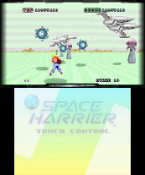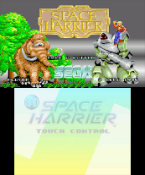Never thought of this game as an endless runner, but I guess it sort of is. I've played the Sega Ages version on the PS2 the most; thought it was fun, but I really dug the music.
3D Space Harrier Review
|
|
See PixlBit's Review Policies

On 02/10/2014 at 01:00 PM by Matt Snee “Feed me quarters.” |

For those with a nostalgic bent, or for those with money burning like 16-bit fire in their pockets.
Oh, Space Harrier, how should I describe you? Should I compare thee to an endless runner? Thou art more lovely and insane. Rough controls do tire the limbs of any gamer, and this title’s fun supply is far too short. But the eternal summer of my nostalgia for this game shall never fade, nor will the death of the ‘80s cast shadows upon its uniqueness.

What would Shakespeare think of Space Harrier? The answer is simple: he would ask his mom for more quarters. For this is the only way one can afford time with the game, which spits endless obstacles in your face constantly, leading to death upon death upon death. But I believe the Bard would also view this relic favorably – not for its ingenious design or timeless gameplay – but instead for its sheer weirdness and fantastic vision.
Now, I have a confession to make: I was spoiled rotten as a child, and as a result I was one of a handful of people in America who owned a Sega Master System in its heyday. Known mostly as a crappy system, I grew quite fond of the machine and the myriad of titles that always seemed strange compared to the more popular NES catalog. I played it a lot, mostly with games like Alex Kidd in Miracle World, Hang-On, Astro Warrior, Outrun, and of course, Space Harrier.

A sort of bizarre arcade hit, Sega’s classic action game was ported to the Master System at the height of the ‘80s and produced by the legendary Yu Suzuki, who was responsible for many of the company’s hits. In fact, the arcade version was often claimed to be the game of the year back in 1987/88.
What were they thinking?

If you’ve never played it, I’ll do my best to illustrate the game: it is presented in third person, with the camera behind your character, who endlessly runs/flies/floats forward into the screen in what is called “The Fantasy Zone.” Movement is constant, and you race into this landscape as it rushes past you; you dodge obstacles like rocks, and trees, and blast enemies both on the ground and in the air. While low on the screen, you run, but if you lift up you’ll start flying and you can move at any time all over the screen.
The draw distance is pretty good for a pseudo-3D game composed out of sprites and repeating patterns of graphics. You’ll usually see an obstacle or enemy coming from a distance, preparing you to dodge or attack it – well, on most levels, that is, until you get close to the end of the game.

When I was a child, I played the game with my brothers, and my older brother claimed that beating the game was easy: all you had to do was move in a constant circle around the screen, and you won’t be hit as long as you’re constantly shooting your gun. This was always a matter of debate, punctuated by deaths that could be argued this way or that.
But this idea exemplifies what is wrong with Space Harrier: it’s remarkably simple, with very little nuance, and once you play the first few levels you’ve pretty much played the entire game, which just repeats the same content, but faster.
This was standard back in those days, and isn’t so bad. But Space Harrier isn’t terribly fun despite its peculiarity. The limited gameplay and the annoying, confidence-shattering deaths you’ll experience don’t help.
Still, it’s something that should at least be experienced, if not on a classic arcade machine, SMS, or Sega Genesis, then at least on YouTube. I went into this review with great sentiment for the game: it was a standard for a couple years of my childhood. I do love it. But that doesn’t mean I accept it as a great, or even good game.
The 3DS version does correct some of the injustices of its historic past: for one thing, you can endlessly insert quarters with no harm to your real wallet. With the ability to continue three times when your game is over, as well as to the level selection on the main screen, you can cruise through this game and get to its lackluster ending without a sweat.
Even so, a lot of it is not so fun. First of all, there are some seriously cheap levels in this game. Second, you will probably use the D-Pad to control your character, because using the analog stick is crippled by the fact that it constantly re-centers your character in the middle of the screen, leading to… DEATH! Unfortunately, using the D-Pad wears out your thumb quickly as you’re constantly moving (in a circle, around the screen).
As far as the 3D goes – I can’t say I liked it, and I usually DO play with the 3D on my 3DS. But this game, with the 16-bit sprites rushing at you in all directions at high speeds – it’s a little intense. To be honest, it kind of fries your brain if you look at it too long, so I played most of the game with it mercifully off.
Space Harrier is a classic. But that doesn’t mean it’s good. I don’t know what the designers were thinking when they made it, and I really don’t know what I was thinking when I used to play the hell out of it, along with hundreds of thousands of kids across the world. It’s become more of a curiosity than anything else, a kind of blip in the history of video games the likes of which will probably be never seen again. But whether you’re playing descendents like 3D World Runner, or even Rez, Space Harrier lives on.










Comments